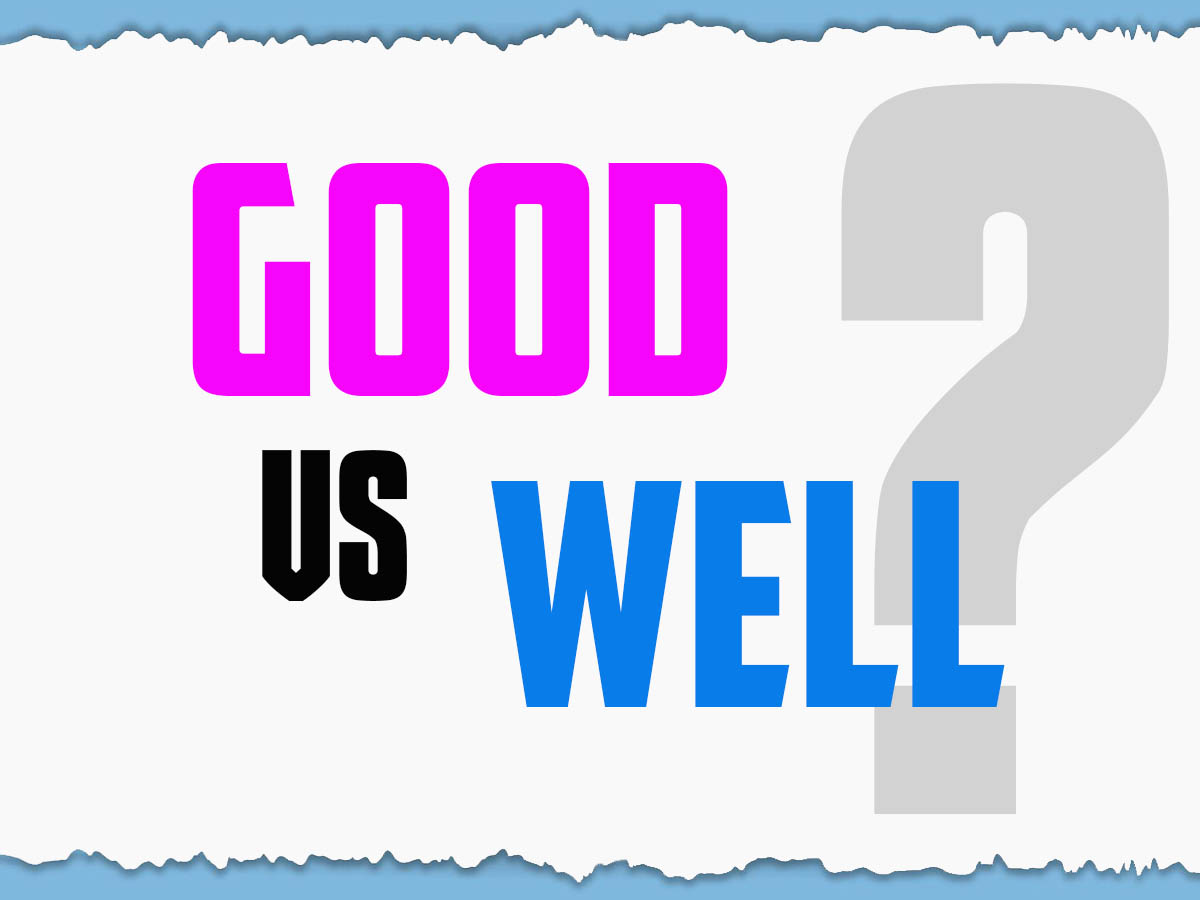‘Good’ vs. ‘Well’. Understanding the difference between these commonly confused words can greatly enhance your communication skills.
Many people use ‘good’ and ‘well’ interchangeably, but they actually serve different purposes. While ‘good’ is an adjective that describes a noun, ‘well’ is an adverb that modifies a verb, adjective, or another adverb. Confused? Don’t worry, we’ve got you covered!
We will break down the correct usage of ‘good’ and ‘well’ with easy-to-understand explanations and practical examples. We will also explore common mistakes to avoid and provide helpful tips for mastering these words.
Whether you’re writing an important email, giving a presentation, or having a conversation, using the right word can make a significant impact on your message. With our guidance, you’ll gain the confidence to choose ‘good’ or ‘well’ accurately and effectively.
So, let’s dive in and enhance your language skills by understanding the nuances between ‘good’ and ‘well’.
Understanding the Difference between “Good” and “Well”
To use ‘good’ and ‘well’ correctly, it’s important to understand their distinct roles in a sentence. As mentioned earlier, ‘good’ functions as an adjective, while ‘well’ functions as an adverb.
When we say something is ‘good’, we are describing the noun or subject. For example, “The pizza was good.” Here, ‘good’ describes the quality of the pizza. On the other hand, ‘well’ modifies the verb or action. For example, “She sings well.” In this sentence, ‘well’ tells us how she performs the action of singing.
It’s worth noting that ‘good’ can also function as an adverb in certain cases. For example, “I did good on my test.” However, this usage is considered informal and should be avoided in formal writing.
Now that we have a clear understanding of their roles, let’s explore the proper usage of ‘good’ and ‘well’ in more detail.
Read More: What Does WRD Mean in Text
Proper Usage of “Good” and “Well”
To use ‘good’ correctly, we need to remember that it is an adjective that describes a noun. It answers the question “What kind?” or “Which one?” Let’s look at a few examples:
- “She is a good friend.” – In this sentence, ‘good’ describes the quality of the friend. It tells us that she possesses positive qualities as a friend.
- “This is a good book.” – Here, ‘good’ describes the quality of the book. It tells us that the book is of high quality or enjoyable to read.
- “He did a good job on the project.” – In this sentence, ‘good’ describes the quality of the job. It tells us that the job was done well or satisfactorily.
Now, let’s move on to the proper usage of ‘well’ as an adverb.
To use ‘well’ correctly, we need to remember that it modifies a verb, adjective, or another adverb. It answers the question “How?” or “To what extent?” Let’s see some examples:
- “She sings well.” – In this example, ‘well’ tells us how she performs the action of singing. It indicates that she has a good singing ability.
- “He played the piano well.” – Here, ‘well’ tells us how he played the piano. It indicates that he played with skill or proficiency.
- “The car runs well.” – In this sentence, ‘well’ tells us how the car runs. It indicates that the car operates smoothly or without any issues.
By understanding the appropriate usage of ‘good’ and ‘well’, we can ensure that our sentences are grammatically correct and convey the intended meaning accurately.
Examples of Using “Good” Correctly
To further illustrate the correct usage of ‘good’, let’s explore some examples:
- “She is a good student.” – Here, ‘good’ describes the quality of the student. It suggests that she is diligent, hardworking, and performs well academically.
- “The movie received good reviews.” – In this sentence, ‘good’ describes the quality of the reviews. It implies that the reviews were positive and praised the movie.
- “He made a good decision.” – Here, ‘good’ describes the quality of the decision. It suggests that the decision was wise, well-thought-out, and had positive outcomes.
Remember, when using ‘good’, pay attention to the noun or subject you are describing and use it to convey positive qualities or characteristics.
Examples of Using “Well” Correctly
Now, let’s take a look at some examples that demonstrate the correct usage of ‘well’ as an adverb:
- “She speaks French well.” – In this example, ‘well’ modifies the verb ‘speaks’ and tells us how she speaks French. It suggests that she speaks the language with proficiency or fluency.
- “The team performed well in the competition.” – Here, ‘well’ modifies the verb ‘performed’ and tells us how the team performed. It implies that the team achieved good results or displayed a high level of skill.
- “The medicine worked well for her.” – In this sentence, ‘well’ modifies the verb ‘worked’ and tells us how the medicine worked. It suggests that the medicine had a positive effect or produced the desired outcome.
When using ‘well’, focus on how the action or verb is being performed and choose the adverb accordingly to provide clarity and precision in your communication.
Common Mistakes when Using “Good” and “Well”
Now that we have explored the correct usage of ‘good’ and ‘well’, let’s discuss some common mistakes to avoid:
- Using ‘good’ as an adverb: While ‘good’ can be used as an adverb in informal speech, it is considered incorrect in formal writing. Instead, use ‘well’ as the adverb form.
- Confusing ‘good’ and ‘well’ in the comparative form: When comparing two things, use ‘better’ for ‘good’ and ‘better’ for ‘well’. For example, “She sings better than him” (comparing the quality of singing) and “She performs better than him” (comparing the manner of performance).
- Misplacing ‘good’ and ‘well’ in sentence structure: Remember to place ‘good’ before the noun it describes and ‘well’ before the verb or adjective it modifies. Placing them correctly ensures grammatical correctness and clarity.
By avoiding these common mistakes, you can refine your usage of ‘good’ and ‘well’ and communicate more effectively.
Tips for Mastering the Usage of “Good” and “Well”
To master the usage of ‘good’ and ‘well’, consider the following tips:
- Read extensively: Reading various types of literature, articles, and other written materials can expose you to correct usage and help you internalize the patterns and contexts in which ‘good’ and ‘well’ are used.
- Practice speaking and writing: Actively practice using ‘good’ and ‘well’ in your everyday conversations and written communication. The more you practice, the more comfortable and accurate you will become in choosing the right word.
- Use online resources: Take advantage of online grammar resources, tutorials, and quizzes that focus on ‘good’ and ‘well’. These resources can provide additional explanations, examples, and exercises to reinforce your understanding.
- Seek feedback: Ask a friend, colleague, or mentor to review your writing or listen to your spoken language and provide feedback on your usage of ‘good’ and ‘well’. Constructive feedback can help you identify areas for improvement and refine your skills.
Remember, mastering the usage of ‘good’ and ‘well’ requires practice and continuous learning. By incorporating these tips into your language-learning routine, you can become more proficient in choosing the correct word in different contexts.
Practice Exercises to Improve Your Understanding
To reinforce your understanding of ‘good’ and ‘well’, here are a few practice exercises:
- Fill in the blanks with either ‘good’ or ‘well’ to complete the sentences:
- She plays the guitar ______.
- The food at the restaurant was ______.
- He did ______ on his math test.
- Rewrite the following sentences using ‘good’ or ‘well’ in the correct positions:
- “He swims good.”
- “The team performed good in the tournament.”
Completing these exercises will help you apply the concepts discussed earlier and deepen your understanding of ‘good’ and ‘well’.
Additional Resources for Learning More about “Good” and “Well”
To further enhance your understanding of ‘good’ and ‘well’, here are some additional resources you can explore:
- Merriam-Webster: A trusted online dictionary that provides definitions, examples, and usage notes for ‘good’ and ‘well’.
- Grammarly: An informative blog post by Grammarly that explains the difference between ‘good’ and ‘well’ with practical examples.
- English Grammar Online: A comprehensive guide on the usage of ‘good’ and ‘well’ with explanations, examples, and exercises.
By exploring these resources, you can deepen your knowledge and gain more confidence in using ‘good’ and ‘well’ accurately.
Frequently Asked Questions about “Good” and “Well”
- Can ‘good’ be used as an adverb?
- Yes, ‘good’ can be used as an adverb in informal speech, but it is considered incorrect in formal writing. It is best to use ‘well’ as the adverb form.
- Is it correct to say ‘I’m good’ instead of ‘I’m well’?
- Yes, both ‘I’m good’ and ‘I’m well’ are correct. However, ‘I’m well’ is more commonly used to indicate overall health or well-being, while ‘I’m good’ is often used to express contentment or satisfaction.
- Are there any exceptions to the usage of ‘good’ and ‘well’?
- While ‘good’ and ‘well’ have specific roles, there can be exceptions and idiomatic expressions where their usage may vary. It’s important to learn these exceptions in context and through exposure to the language.
- How can I remember when to use ‘good’ and ‘well’?
- Practice and exposure are key to remembering the correct usage of ‘good’ and ‘well’. The more you read, write, and speak in English, the more natural and intuitive the usage will become.
By providing answers to these frequently asked questions, we hope to address any lingering doubts or confusion you may have had about ‘good’ and ‘well’.
My Closing Thoughts
Understanding the difference between ‘good’ and ‘well’ is essential for effective communication. By recognizing that ‘good’ is an adjective that describes a noun, while ‘well’ is an adverb that modifies a verb, adjective, or another adverb, you can use these words accurately and confidently.
Remember to use ‘good’ to describe the quality of a noun and ‘well’ to describe how an action is performed. Avoid common mistakes, practice regularly, and seek feedback to improve your usage of ‘good’ and ‘well’.
With diligent practice and the resources provided, you’ll soon develop a strong grasp of ‘good’ and ‘well’ and be able to communicate with precision and clarity. Happy writing and speaking!

